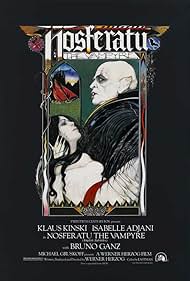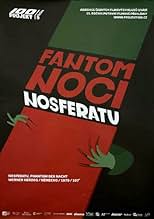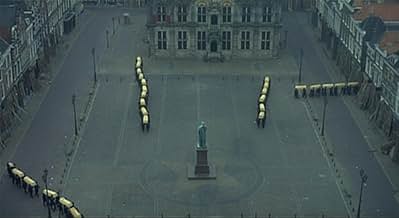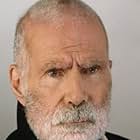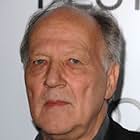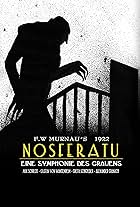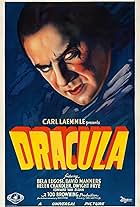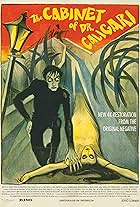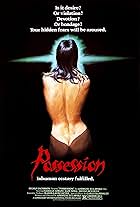Count Dracula moves from Transylvania to Wismar, spreading the Black Plague across the land. Only a woman pure of heart can bring an end to his reign of horror.Count Dracula moves from Transylvania to Wismar, spreading the Black Plague across the land. Only a woman pure of heart can bring an end to his reign of horror.Count Dracula moves from Transylvania to Wismar, spreading the Black Plague across the land. Only a woman pure of heart can bring an end to his reign of horror.
- Awards
- 5 wins & 8 nominations
Rijk de Gooyer
- Town official
- (as Ryk de Gooyer)
Michael Edols
- Lord of the Manor
- (uncredited)
Werner Herzog
- Hand and Feet in Box with Rats
- (uncredited)
Storyline
Did you know
- TriviaKlaus Kinski had to spend approximately four hours per day in make-up. Fresh latex ear pieces had to be poured for each day of shooting because they were destroyed at removal. Kinski, notorious for his violent daily temper-tantrums, had a very good relationship with Japanese make-up artist Reiko Kruk and was exceedingly patient and well-behaved during make-up. Kinski himself said of the make-up that he hated being excessively made up for a role, but for the role of Dracula it was important so he took it in stride. Kinski was so disturbed by his appearance in the make-up that he avoided looking in any mirrors during filming.
- Goofs(at around 58 mins) When the captain of the ship is writing in his log he says they left the Caspian Sea, which is landlocked and nearly 1000 miles away from the port in Bulgaria where the voyage started. Bulgaria is on the Black Sea.
- Quotes
Count Dracula: [subtitled version] Time is an abyss... profound as a thousand nights... Centuries come and go... To be unable to grow old is terrible... Death is not the worst... Can you imagine enduring centuries, experiencing each day the same futilities...
- Alternate versionsThe English-language version was only available in a shorter cut until 2000, which was about 10 minutes shorter.
- ConnectionsEdited into Catalogue of Ships (2008)
- SoundtracksRheingold
Written by Richard Wagner
Performed by Wiener Philharmoniker
Conducted by Georg Solti (as Sir Georg Solti)
Decca LC 0171
Featured review
Another classic collaboration of Werner Herzog and Klaus Kinski, Nosferatu is not just a remake of the F. W. Murnau silent classic, but an extension of it. Herzog not only develops the Stoker story more directly than the original did, but even reintroduces the original characters - Orlok becomes Dracula, and the Hutters become the Harkers.
Like many of the films involving Herzog and Kinski, Nosferatu is a period piece and creates the context of its plot through beautiful cinematography and a relentless but unhasty pace, not through the script. ThoughKinski dominates the screen just as he always does in these collaborations, the performances of fellow greats Isabelle Adjani and Bruno Ganz are also worthy of mention. Ganz's Jonathan Harker is certainly the most sympathetic character in the film, and Adjani's Lucy is beautiful, spooky, and just odd enough to fit the role perfectly.
Nosferatu is a retelling of the Dracula tale. Unlike its generally inferior competitors, Nosferatu - both the 1922 and 1979 versions - sticks very close to Bram Stoker's text - neither elaborating the focus on bloodsucking (obsessed upon by most American interpretations of Dracula), nor revising Jonathan Harker and Dr. Van Helsing as heroic characters, nor adding erotic or romantic elements to the depravity of the original concept. If you know what Stoker was about, you will thrill to the often forgotten aspects of Stoker's novel which are redeemed here - the plague rats, the gypsies, etc.
Kinki's intensity allows him to become a perfect Dracula. He understands his role perfectly and never once slips out of 'the hunter'. This is another very important aspect of the Stoker legend which has been sadly contorted by the popularization of the Dracula legend. Nosferatu's Count Dracula is not a charming eastern European gentleman with a quirky bloodsucking habit and a lovesick soul, he is a wily, terrifying, soulless, inhuman, obsessive, predator. And he has absolutely no concern for the affairs of Homo sapiens sapiens.
The film is mostly shot in Amsterdam's old city, which fits the mood of the film well. Other locations are in Germany, and Dracula's castle, for once, is an actual castle - even the interior shots! The wonderfully eerie and disorienting Popul Vuh soundtrack compliments the typically Herzogian picture-perfect visuals.
This is a great film for those seeking an accessible introduction to film-as-art, and the legendary collaborations of Herzog and Kinski. It will likely annoy those who think of Dracula as a good looking romantic guy with a nasty habit, but is highly recommended for fans of Stoker's original work.
.
Like many of the films involving Herzog and Kinski, Nosferatu is a period piece and creates the context of its plot through beautiful cinematography and a relentless but unhasty pace, not through the script. ThoughKinski dominates the screen just as he always does in these collaborations, the performances of fellow greats Isabelle Adjani and Bruno Ganz are also worthy of mention. Ganz's Jonathan Harker is certainly the most sympathetic character in the film, and Adjani's Lucy is beautiful, spooky, and just odd enough to fit the role perfectly.
Nosferatu is a retelling of the Dracula tale. Unlike its generally inferior competitors, Nosferatu - both the 1922 and 1979 versions - sticks very close to Bram Stoker's text - neither elaborating the focus on bloodsucking (obsessed upon by most American interpretations of Dracula), nor revising Jonathan Harker and Dr. Van Helsing as heroic characters, nor adding erotic or romantic elements to the depravity of the original concept. If you know what Stoker was about, you will thrill to the often forgotten aspects of Stoker's novel which are redeemed here - the plague rats, the gypsies, etc.
Kinki's intensity allows him to become a perfect Dracula. He understands his role perfectly and never once slips out of 'the hunter'. This is another very important aspect of the Stoker legend which has been sadly contorted by the popularization of the Dracula legend. Nosferatu's Count Dracula is not a charming eastern European gentleman with a quirky bloodsucking habit and a lovesick soul, he is a wily, terrifying, soulless, inhuman, obsessive, predator. And he has absolutely no concern for the affairs of Homo sapiens sapiens.
The film is mostly shot in Amsterdam's old city, which fits the mood of the film well. Other locations are in Germany, and Dracula's castle, for once, is an actual castle - even the interior shots! The wonderfully eerie and disorienting Popul Vuh soundtrack compliments the typically Herzogian picture-perfect visuals.
This is a great film for those seeking an accessible introduction to film-as-art, and the legendary collaborations of Herzog and Kinski. It will likely annoy those who think of Dracula as a good looking romantic guy with a nasty habit, but is highly recommended for fans of Stoker's original work.
.
Details
- Release date
- Countries of origin
- Languages
- Also known as
- Nosferatu, vampiro de la noche
- Filming locations
- Delft, Zuid-Holland, Netherlands(many exteriors)
- Production companies
- See more company credits at IMDbPro
Box office
- Gross worldwide
- $3,389
- Runtime1 hour 47 minutes
- Sound mix
- Aspect ratio
- 1.85 : 1
Contribute to this page
Suggest an edit or add missing content

